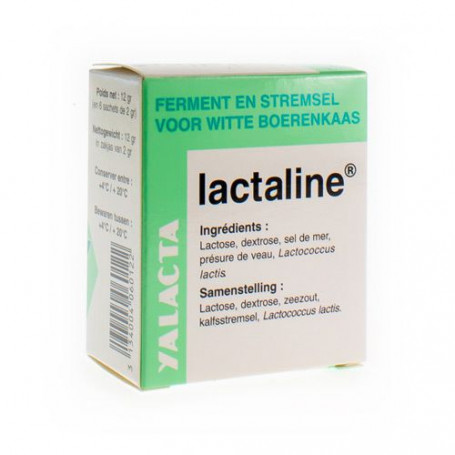Yalacta Lactaline Fromage Blanc Sachet 6x2g
YALACTA.
Intestinal inflammation, diarrhea and probioticum ...
Ferments of yoghurt, the bulgarians.
Preparation of enzymes:
Pour the powder into a coffee cup that you have meticulously cleaned. Add two teaspoons of milk and mix well to obtain a solution smooth and homogeneous;
Continue to mix and dilute, in the meantime, little by little to the solution with the milk until you have a volume of half a cup of yogurt (= mixture of fermentation);
Then, cover the cup and allow to rest for 1 to 2 hours. Ferments dry need this time to regain their maximum efficiency. It is only at this moment that the mixture of fermentation will be ready to be used;
With a dose of ferments (a first mixture of a fermentation or solution fermentante) you can perform 20 to 25 operations of transplanting (sowing).
Preparation with milk:
The choice of milk is very important. It can be raw, pasteurized or sterilized. In addition, you can use the milk for long preservation (sterilization U. H. T.), milk powder, fast or milk directly from the farm. The packaging, the brand and origin are of no sort of importance. The main thing is that it is a question of milk quality. Nevertheless, we would like to draw your attention on the following points:
It is not so obvious that a type of milk of one and the same brand has in other countries, or even in different regions of the same country, the same quality or that it is of the same quality throughout the year (the packaging is done in different institutions);
If you are using raw milk (milk from the farm or pasteurized milk, you must boil it before;
If you opt for milk powder, quickly soluble, you need to ensure that the water used to obtain the solution to be of good quality;
If you like yogurt strong (regardless of the type of milk used), you will need to (just like the Bulgarians still do to this day) warm the milk for 10 to 15 minutes at 90 - 100 °C and then allowed to cool.
Add the mixture of fermentation (enzymes):
If you have an electrical device to produce yogurt, you will need to wait until the milk has cooled down.
With a classic camera non-electric you add the starter when the milk has a temperature of 50 to 55 °C.
There are two possibilities at this point:
Either you add at once the mixture of fermentation that you have prepared (seeding total and immediate of all the milk used). Using a whisk or a fork, you mix therefore the mixture for at least 30 seconds. Then, you divide the milk with ferments (homogeneous liquid) in small pots or in the tray of your device to make yogurt.
Either you pour into each small pot of your device for the manufacture of yogurt two teaspoons of the mixture of fermentation that you have made (seeding of each individual small pot). Attention now! To ensure a good distribution of the enzymes in each small pot, you need to vigorously shake each one of them.
The following preparations (up to 150 yogurt from the same starter):
To continue without the use of new enzymes, you will need to do so:
Choose the yogurt the more successful your first preparation;
Using a teaspoon you carefully remove the small skin of the surface, as they may be contaminated with bacteria or fungi are located in the surrounding air;and
Again add seeds (seeding in the middle of the yogurt the more successful), as well as in the first preparation. Now, you can put a single teaspoon in each small pot or half a yogurt per litre of milk to obtain;
Mix well;
Leave to ferment, but not as long as the first time (more or less an hour less).
What to do if...
If you want to get yogurt more solid and sour. If your device for the manufacture of yogurt allows it, you need to do is set the fermentation temperature (it must be somewhat above the 45 °C;
If you want to get yogurt more sweet, less sour, but still smooth. If your device for the manufacture of yogurt allows it, you need to do is set the fermentation temperature somewhat below 45 °C. With a device to make yogurt you only need to ensure that the setting knob of the temperature to be between 40 and 50 °C in order to be sure that the seeds remain alive;
If you wish to make yogurt thick and creamy. It is preferred to use milk, not skimmed or semi-skimmed. If you use milk fully skimmed, your yogurt will be more fragile. However, you can thicken it by adding two tablespoons well clear of skimmed-milk powder;
If you find your yogurt is too sour and grainy (too many lumps + a discharge of clear serum on the surface). It is very likely that this irregularity is caused by an incubation temperature too high and (or) too long. Therefore, keep an eye on these two important points.




